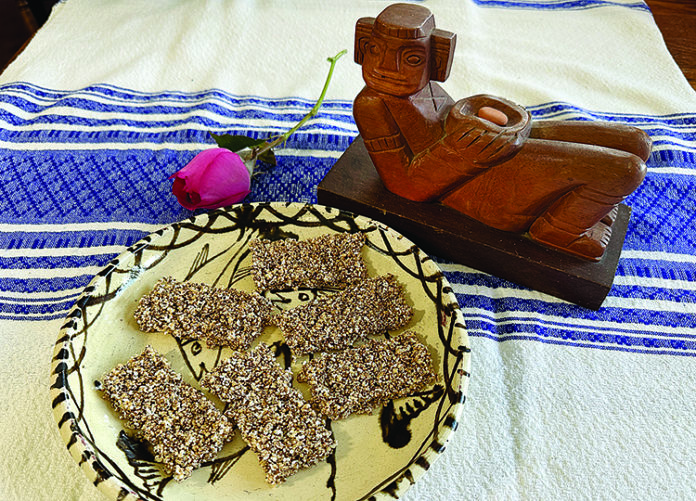
There is a tiny seed that at one time was second only to corn, as a very important part in the diet of the ancient Aztecs.
The seeds come out of tiny pink flowers that grow in large clusters on the Amaranth bush; 60,000 seeds can be harvested off of one plant. It grows all over the world, although it is thought to be native to the Americas. In many places it is considered an invasive weed.
Archeological evidence in the Puna desert in Argentina dates back to 4,500 years ago and its presence is seen as evidence of pre-Columbian oceanic contact.
Anurudh K. Singh, in his writings “Early History of Crop Introductions into India” reported on archeological evidence of amaranth dating back to 1000-800 BCE.
The seeds are rich in amino acids, iron, protein, calcium, magnesium, phosphorus and potassium, although the entire plant is edible. The leaves are eaten like spinach in Asia, Africa and Europe. The flower of one particular species was used by the Hopis to make a deep red dye.
One very odd characteristic of the seeds is that they pop like corn. In a hot pan without oil, add a heaping teaspoon of seeds. Cover and shake the pan listening for the seeds to stop popping. The flavor is delicious and similar to popcorn but it is difficult to keep them from burning. The seeds can also be boiled with water to make a gruel or ground into flour and made into tamales or tortillas
In Aztec time, the toasted and popped seeds were mixed with honey or sap from the agave cactus, formed into little idols of the gods and then presented in temples. Now, in Mexico, they are made into candies called alegrías, formed into disks or bars, sometimes with seeds or nuts added.
With this recipe, you are nearly cooking like the Aztecs. I made the seed, nut and agave syrup mixture into delicate bars by pressing it into a pan, but you could form them into other shapes or icons like the Aztecs did. Bulk raw amaranth grain, green pumpkin seeds and blue agave syrup are available at Staff of Life, 906 E. Lake Ave. I was amazed to find popped amaranth, amaranto, at the new mega store, Vallarta, that just opened on Freedom Boulevard.
1 3/4 cups toasted and popped amaranth grain
1 cup toasted green pumpkin seeds, 1/2 cup whole and 1/2 cup ground
2/3 cup honey or agave syrup
1/2–1 teaspoon salt
Prepare a pan by putting parchment paper in the bottom of an 8-inch square cake pan.
Toast the pumpkin seeds in a pie tin at 325 degrees for about 12 minutes until they turn golden brown. Let cool completely. When cool, grind half of the seeds in a blender.
Toast the amaranth in a small covered pan over medium-high heat for about 30 seconds, one heaping teaspoon at a time. Not all the seeds will pop unfortunately. They just need to be toasted. Put the toasted/popped seeds in a medium sized bowl. Add the whole and ground pumpkin seeds and stir in salt to taste.
Melt honey or agave syrup over medium low heat until it flows like water.
Add ½ cup of the honey/agave syrup to the bowl of seeds and mix completely until seeds and nuts stick together when you pinch them with your hands. Add more if necessary and mix well with a rubber spatula. Press the mixture into the pan. Let sit for a few hours. You can refrigerate the pan for two hours, although the Aztecs didn’t have electric refrigerators. Cut into rectangles.











